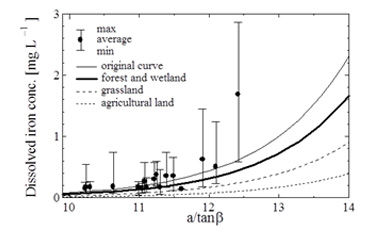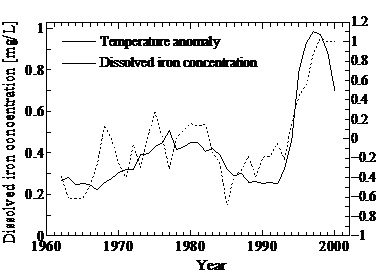Topography as a macroscopic index for the dissolved iron productivity of different land cover types in the Amur River Basin
Onishi T. Yoh M. Shibata H. Nagao S. Kawahigashi M. Shamov V.V. Hydrological Research Letters (2010)
 Iron is the limiting nutrient of phytoplankton in the Sea of Okhotsk, and the majority of iron in this system is fed by the Amur River. The recent conversion of wetlands, the main source of iron in the Amur River basin, to agricultural lands will likely impact dissolved iron productivity, which may also influence primary production in the Sea of Okhotsk.
Iron is the limiting nutrient of phytoplankton in the Sea of Okhotsk, and the majority of iron in this system is fed by the Amur River. The recent conversion of wetlands, the main source of iron in the Amur River basin, to agricultural lands will likely impact dissolved iron productivity, which may also influence primary production in the Sea of Okhotsk.
Therefore, this study was conducted to construct a macroscopic index for use in assessing dissolved iron productivity in the basin. Correlation analysis between climate and topographic parameters and the observed dissolved iron concentration in forests and wetlands revealed that the topographic wetness index (TWI) had a significant correlation with dissolved iron concentration. An exponential curve was found to be the best curve to express this correlation. We assumed that dissolved iron concentration for grasslands and agricultural lands, the other two dominant land cover types,could also be expressed by TWI. Based on this assumption, dissolved iron concentration curves for grasslands and agricultural lands were inversely identified by systematic modification of the curve for forests and wetlands. The results suggest that TWI can describe the average dissolved iron concentration of major land cover types in the basin.
Dissolved iron runoff in Amur Basin rivers in the Late XX Century
Shamov V.V. Onishi T. Kulakov V.V. Water Resources (2014)
 Analysis of long-term dissolved iron concentration of the Amur River basin indicates that abnormal rise of dissolved iron concentration of the period is ubiquitous throughout the basin, suggesting the prevailing phenomena such as climate conditions has large influence. Thus, correlation analysis between dissolved iron concentration and temperature and precipitation was conducted. The result shows that July temperature has strong correlation with dissolved iron concentration. Supported by the fact that soil temperature is also shows increasing trend, we propose that the permafrost dynamics should have a large influence on dissolved iron concentration of rivers.
Analysis of long-term dissolved iron concentration of the Amur River basin indicates that abnormal rise of dissolved iron concentration of the period is ubiquitous throughout the basin, suggesting the prevailing phenomena such as climate conditions has large influence. Thus, correlation analysis between dissolved iron concentration and temperature and precipitation was conducted. The result shows that July temperature has strong correlation with dissolved iron concentration. Supported by the fact that soil temperature is also shows increasing trend, we propose that the permafrost dynamics should have a large influence on dissolved iron concentration of rivers.
